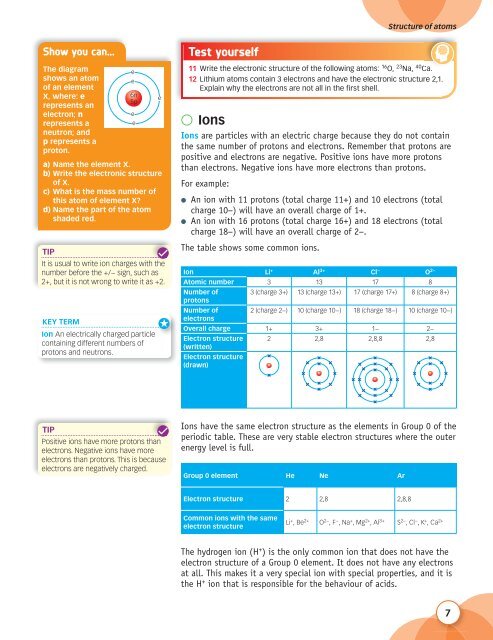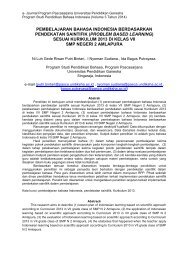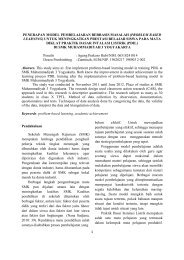Create successful ePaper yourself
Turn your PDF publications into a flip-book with our unique Google optimized e-Paper software.
Structure of atoms<br />
Show you can...<br />
The diagram<br />
shows an atom<br />
of an element<br />
X, where: e<br />
represents an<br />
electron; n<br />
represents a<br />
neutron; and<br />
p represents a<br />
proton.<br />
e<br />
e<br />
6n<br />
5p<br />
e<br />
e<br />
TIP<br />
It is usual to write ion charges with the<br />
number before the +/− sign, such as<br />
2+, but it is not wrong to write it as +2.<br />
KEY TERM<br />
Ion An electrically charged particle<br />
containing different numbers of<br />
protons and neutrons.<br />
e<br />
a) Name the element X.<br />
b) Write the electronic structure<br />
of X.<br />
c) What is the mass number of<br />
this atom of element X?<br />
d) Name the part of the atom<br />
shaded red.<br />
Test yourself<br />
11 Write the electronic structure of the following atoms: 16 O, 23 Na, 40 Ca.<br />
12 Lithium atoms contain 3 electrons and have the electronic structure 2,1.<br />
Explain why the electrons are not all in the first shell.<br />
● Ions<br />
Ions are particles with an electric charge because they do not contain<br />
the same number of protons and electrons. Remember that protons are<br />
positive and electrons are negative. Positive ions have more protons<br />
than electrons. Negative ions have more electrons than protons.<br />
For example:<br />
● An ion with 11 protons (total charge 11+) and 10 electrons (total<br />
charge 10−) will have an overall charge of 1+.<br />
● An ion with 16 protons (total charge 16+) and 18 electrons (total<br />
charge 18−) will have an overall charge of 2−.<br />
The table shows some common ions.<br />
Ion Li + Al 3+ Cl − O 2−<br />
Atomic number 3 13 17 8<br />
Number of 3 (charge 3+) 13 (charge 13+) 17 (charge 17+) 8 (charge 8+)<br />
protons<br />
Number of 2 (charge 2−) 10 (charge 10−) 18 (charge 18−) 10 (charge 10−)<br />
electrons<br />
Overall charge 1+ 3+ 1− 2−<br />
Electron structure 2 2,8 2,8,8 2,8<br />
(written)<br />
Electron structure<br />
(drawn)<br />
TIP<br />
Positive ions have more protons than<br />
electrons. Negative ions have more<br />
electrons than protons. This is because<br />
electrons are negatively charged.<br />
Ions have the same electron structure as the elements in Group 0 of the<br />
periodic table. These are very stable electron structures where the outer<br />
energy level is full.<br />
Group 0 element He Ne Ar<br />
Electron structure 2 2,8 2,8,8<br />
Common ions with the same<br />
electron structure<br />
Li + , Be 2+ O 2− , F − , Na + , Mg 2+ , Al 3+ S 2− , Cl − , K + , Ca 2+<br />
The hydrogen ion (H + ) is the only common ion that does not have the<br />
electron structure of a Group 0 element. It does not have any electrons<br />
at all. This makes it a very special ion with special properties, and it is<br />
the H + ion that is responsible for the behaviour of acids.<br />
7





